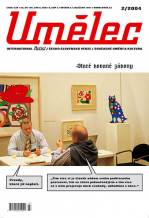| Umělec magazine 2001/1 >> Forever Leading Culture | List of all editions. | ||||||||||||
|
|||||||||||||
Forever Leading CultureUmělec magazine 2001/101.01.2001 Keiko Sei | theory | en cs |
|||||||||||||
|
"The American novelist Walter Abish has described the work of the younger writer Jürg Laederach (who wrote the novel Wie Deutsch Ist Das on the German psyche) as capturing “the spirit of the new Europe”:
“A Europe to come, when borders dissolve [...] Characters vanish, reappear. The short segments are sharply defined. There is something relentless about the build up... Everything is transitory. No sentimentality. No clinging to the past. Everything is on the verge of being discarded. Everything is on the verge of dissolution. Everything resonates with imminent change.”1 That much is true, aside from the fact that the reason everything is transitory and on the verge of being discarded is not because new Europe involves the dissolution of its borders but because the old Europe way is to create new borders. The description strongly reminds me of the scene at the border of the former DDR and the Czech Republic, where two new nations come together — one united, one dissolved. Women are standing on the roadside. Vietnamese merchants sell goods to travelers. Winter is particularly stunning, with women in miniskirts who come from as far away as Bulgaria, Ukraine and elsewhere, and hundreds of garden gnomes being sold by the Vietnamese all propped up in the snow. Glasshouse brothels where girls dance naked under disco lights or simply stand at the edge of the cold, dark forest. Here everyone is transitory. No sentimentality. No clinging to the past. Everybody is on the verge of being discarded and everybody is on the verge of dissolution. The prostitutes are from distant places, many smuggled in, captured and illegal. The merchants are from even further east, all involved in some kind of illegal business, selling smuggled cigarettes and the Polish-made gnomes that the Germans claim are fakes. Their legal status is a constant fear because of the creation of the so-called new Europe and the new Czech immigration law. They all know that what they do and where they are and what they are is only temporary and sometimes they even hope that this is the case. The consumers are German tourists just passing through, and they too are aware that their time here is only temporary. Everything resonates with impending change. The Chinese and Vietnamese merchants are adaptable people. They sell anything you can’t normally find in a market, wherever they go, for a lower price than local shops; specialty goods sometimes without any apparent use. Travelers pull over when they see something cheap that they know they want, or when they notice something absolutely strange that they can’t identify. Usually one of the two. In this manner they were successful at business in the former Soviet Union. In many cities, such as Vladivostok, their market is possibly the only commercial mechanism that is up and running at the moment. Importing (or smuggling) cheap garden gnomes from Poland to the Czech Republic and selling them to Germans who complain that the not-so-authentic Polish gnomes are ruining the authentic German gnome industry is a phenomenon of the Far East merchants. For those more or less involved in art or media theory, there are many symbolic and representational levels at stake in this gnome matter alone. First there is the issue of the so-called authenticity of the gnome figure. Secondly, the fact that the image of the gnome, or dwarf, is itself taken from Europe, exported to the world by America (Disney), and re-imported to Europe again in an unending cycle. What is remarkable about the Far East merchants is that they do this all over the world. In other words, they are the middlemen in the trafficking of signs. We also notice here the non-sentimentality of their deed, which is the strength of the middleman. In the case of a gnome, it is the Germans who are vulnerable. They are the ones who have to face a non-authentic, Polish-made gnome and are thereby at risk of sentimentality. Take a look at the goods sold by Chinese and Vietnamese merchants in the center of Prague. Small laser-beam key holders that form different figures such as naked women. A gas lighter shaped like Ultraman (a popular Japanese TV superhero) that flames from his mouth. A fake or real hand-carved European dagger. An unauthorized Pokemon doll. A huge sunbathing towel with an image from Titanic. Whether someone becomes sentimental or not upon seeing any of these things all depends on where the objects end up being sold. (For example, I become sentimental when I see my little Japanese TV hero gas lighter in Prague, far away from home, yet it means nothing at all to a Czech consumer.) In any case, however, the travelling middleman remains stoically non-sentimental. The trafficking of signs happens in the arts as well. Take for example the famous myth of the birth of video art. Nam Jun Paik, a Korean man who had studied in Japan and Germany, came to New York, bought the first SONY video port-a-pack that had just arrived in the US from Japan and he just happened to witness the Pope’s visit in town. He showed the first video image with a Sony port-a-pack in an alternative space at the club Cafe Go Go in the mid-1960s. This episode, together with separate installations by Paik and Vostell, who used televisions in 1963, marks the beginning of video art in general. The significance of the two stories is that they more or less determine the two different paths the genre takes, that is, installation (for art galleries) and independent TV, which challenges mass media. There are voices, however, that contest the “official” history of video art. Artists such as Martha Rosler claim that the multiculturalism that Paik bears, which can be seen in the Pope episode, is the very reason a historian is able to create, and be in favor of maintaining, the myth. Therefore what I call sign trafficking could make a considerable impact in the cultural sphere. Around the same time in the late 1960s in Japan the first video art in the region was also about to be born. The experimental filmmaker Toshio Matsumoto was in the middle of the production of his first feature-length film entitled Funeral of Roses. The film is about a gay boy’s sexual liaison with his father after he kills his mother — a reversal of the Oedipus myth. Throughout the film Matsumoto adapted experimental filmmaking techniques, e.g. the periodic juxtaposition of the fictional story with real-life interviews with the actual “gay boy” (the term widely used in Japan for transsexual boys and men who work in night clubs), non-linear time, and so on. The film also captures the atmosphere of the late 1960s. The main character, Eddy, played by Peter, a real-life “gay boy,” ambles around Tokyo witnessing various historical events: street happenings by the art performance group Zero Dimension & Co., a violent student demonstration against the state and Japan’s alliance with America, a drug party, the screening of an experimental film (or what they call “underground film”), and an art exhibition of surrealism and multimedia. During the drug party and the screening of the experimental film made by Guevara — a fictional character — the people at the party magnetically distort the TV image of a previously filmed student demonstration with something like a prototype model of an early Etra/Rutt Scan Processor.2 The event is called Magnetic Scramble and it is thought to be the first video art in Japan (and, apparently, in Asia). Certainly one cannot overlook the relationship between the first video art and the film’s story line, not to mention that the film also served as a record of the transsexual self-emancipating process. When asked what he thought about the experimental film he had just seen, Eddy replied, “I don’t really understand it.” The comment must have been Peter’s real impression of the new form of expression. He was working as a gay boy at a local nightclub in real life when he was picked to play the leading role in the film. Eddy/Peter also encounters the street “happenings” of Zero Dimension & Co., in which the group, wearing black clothes and businessman glasses, silently marches down the street carrying white boxes bound up with bandages — the performance deals with various themes, including a layer of antinuclear sentiment. While people on the street see the happening as something odd, Eddy/Peter follows the group as if he is able to identify with them. When he comes across the art exhibition, he hears a voice coming from an audiotape in the gallery saying, “Everybody wears a mask... Some keep one mask on all their lives and others change masks... Even when a mask is taken off the face that appears isn’t necessarily the real one... Under the first mask there is a second...” When he hears these words he faints. Paik’s first recording of video art with his screening of the Pope’s visit to New York can now be compared with the Magnetic Scramble event. The former involves an artist whose nationality has become irrelevant because he works on so many different continents. (Is he a Korean, German or American artist?) The event includes the transfer of the image of the Pope, the official symbol of religious dogma, to an alternative space. The other event involves a transsexual who asserts that he is not a man, woman, child or adult. That event includes the action of transforming the student demonstration — a symbol of anarchist or Marxist ideology — into a psychedelic, alternative mental state. It is therefore significant for the organizers of these events, in these cases Paik and Matsumoto, to use video, which is a far more “live” media than film, in order to create a kind of transitory phase.3 Admittedly a certain nonsentimentality must be assumed while the events are being realized. Take as an example a scene from Funeral of Roses. Eddy finds a student wearing a helmet lying on the staircase, bleeding, in his apartment building and takes him to his room. He gives him first aid, asking him if it hurt bad. In response to Eddy’s question: “Whey do you use violence? That’s not good,” the student gives a long ideological statement explaining the purpose of their protest against state authority. After the speech Eddy simply says, “Oh, I have go to work now” (at a nightclub called Genet). Eddy evinces no reaction at all to the ideological rant; he only thinks about his nights spent entertaining charming male customers. The scene suggests that his emotions only work on the level of a “motherly” instinct to nurse weaker beings, and dissolve when encountering any ideological stance. The scene functions differently with two different audience groups. A Japanese audience understands it as ideology, in general, dying out. But a Western audience (which is small as the film hasn’t been shown much outside the country) gets the impression that there may be a whole mechanism out there making ideology obsolete. If there is such a thing as a mechanism that makes ideology irrelevant it would indeed be useful to study it in order for us to understand more about ideology itself. The Chinese writer Gao Xingian, the winner of the Nobel Prize for Literature in 2000 who introduced Brechtian and Artaudian theater to the mainland of China and was accused of producing “most pernicious” works of “intellectual pollution” by communist officials in the 1980s, has opposed the embodiment of any ideology into literature and art. He has experimented with various means of pursuing this conviction. One of the methods that he created in his plays is called the “tripartite actor” — a process by which the actor neutralizes himself and achieves a (nonsentimentally?) disinterested observation of his own self in performance. The subject puts himself into the continuous journey of life to discover any other means that might serve his conviction. Here in the Czech Republic, it’s a current topic too when I think of the various problems ranging from why Kundera cannot officially return to his homeland4 to why Karel Gott and Jiří Korn have survived the former regime and still manage to remain big stars. I myself began thinking about the subject when I received a letter from a friend from Tokyo some months ago. It said that she had had a nervous breakdown from overworking — all too common for Japanese workers — and that she needed to take some time off. She sent me the lyrics to one of the songs she was listening to at that time, saying that her exhausted mind had been touched by the song. The lyrics go like this: what’s in the sea only life is in there all of naked history, which would make me totally silly, is in there what’s in the mountain that pride is in there the imprudent mind, so dried out it would stick to a wall, is in there what’s in the field over there is a jewel it is amazing as it takes the place of kitty litter what’s still in the night it can’t be that loneliness when we start turning back we swear our mind remains in March tomorrow what’s in the sky one leaf of... we only choose choose to be there why not just go what’s still in the town sometimes it even makes the big city look faded perhaps it did perhaps it has the skill to surprise silently why not choose and go you why not only choose and go The lyrics, written by the most influential “folk song singer” or “singer song writer” in Japan, Yosui Inoue, struck me because of their deliberate omission of any ideology. Then I remembered the history of his career in relation to the exclusion of ideology. He dispensed with it right from the start, and the method proved to be popular among a wide audience. (His album The World of Ice broke all sales records in the music industry in the 1970s. It features songs with lyrics like: An apple seller is there out the window / An apple seller is shouting himself hoarse / Perhaps somebody is only pretending to be an apple seller / My TV has begun to acquire a serious color because of the chill / It made that ugly girl attractive and then disappeared.) Music and literary critics also praised his songs. As a result of their immense success, the purpose of his songs has gradually become the banishment of ideology along with any expression of ideas. This has borne out the theory that the most successful messagesong writing of all time lacks a message (even if that constitutes an ideology in itself). The lyricist certainly touched the candid desire of millions of people for ideas without meaning. But the question still remains: What in the lyrics moved my friend, the editor of a magazine that introduces from all over the world every new thing that comes along? Fair is foul, foul is fair Kojin Karatani quotes the witches’ words from Macbeth in his book entitled A Disease Called Meaning. The title alone suggests much of what we are discussing here. This line for the philosopher is the key to understanding Shakespeare’s unique viewpoint and consequently his ability to describe the human mind as it is. Anything can happen in the human mind and when it does happen, he simply describes it as one of the “realities,” that is to say, “nature” and nothing more. As with the logician Karatani, we are all delighted when we encounter brilliant technical skill in any artistic activity, more than with anything else. In order to have a grasp on technique one must consider all the conditions that are required to fulfil the task. And the conditions are always limited: tools and engineering, time, physical space, social environment and the like. Therefore when we are pleased to see good technique it is because we know that the creator knows that the (human) world is limited. We then see the creator’s penetrating vision figuring out the possibilities of creating something within limited conditions. Thus the more excellent the work created, the more it reveals the limitations of the employed media and vice versa. The most recent salient examples are Internet art and activism. The artists who avail themselves of them are supposed to acquire “a whole new thinking” in treating the new media, and it is true in a sense that whoever does interesting work on the Internet understands its limitations more than anybody else. Therefore any good work contains the hidden understanding between the creator and the viewer that they share the common problem that “my” condition is limited. In Central Europe, conceptual techniques such as surrealism or Dadaism used to be enormously effective in making an audience aware of the problem of including or excluding ideas. It was this insight that made them so influential. At a time when the media dominate in all spheres of society, however, there seem to be no techniques that stand out as winning formulas. In the Czech Republic, absurdism and Hašekian methods can still be seen almost everywhere, but even this will slowly change as more and more people watch foreign TV programs. Simply put, cultural and social proximity, or proxemics, as E. Hall calls it, reflects differently in different cultures and one begins to lose a sense for one’s own proxemics when steeped in another culture. In Japan, however, one technique has been so efficient throughout history that there is need to find a “new” one, particularly in the age of media. Kitsch has fit comfortably into every new media that has come out till now. I must begin by explaining that there is something like a “Buddhist Kitsch,” which today’s kitsch is based on. Yet it doesn’t mean the kitsch created by the believers of a religion, which can be seen in Latin American Catholic kitsch, nor that created by provocateurs, such as Rosa von Praunheim’s kitsch speaking against Bavarian Catholicism. The term refers to the Buddhist environment that allows kitsch to enjoy its life. Its history goes back to long before the word “kitsch” came into common usage in Europe at the turn of the 20th century. So the esthetic has been around for a long time but was, and still is in many cases, called something else; in fact there were a number of terms and phrases. Let’s take a look at the lyrics from the old folk song “An Ancient Priest in a Mountain Temple” that all Japanese children sing at some point in their lives: An ancient priest in a mountain temple Wants to kick a ball, but there is no ball So he puts a cat in a bag He kicks it Pon! The cat meows Nyan! The meow somehow meows Yoi Yoi Lyrics such as these are not possible in a Christian nursery song because they would be understood as a description of a priest’s abuse of animals, a possibly corrupting influence on children. Yet all Japanese love the song simply because it is meaningless. For Westerners it is impossible for something to mean nothing, but it is possible in Asia and what else can we say? In fact this very “it is possible to mean nothing and what else we can say?” spirit is the very essence of the kitsch that I am talking about here. Next we’ll look at a comic by the popular comic writer Fujio Akatsuka. The scene takes place after the main character, the father of an idiot, calls on a Buddhist monk to carry out a funeral ceremony for an insect that keeled over after he showed it a picture of a naked woman. The Genius Bakabon P: Bakabon’s papa M: Monk 40. P: What, what are you doing!? 41. M: Where is the soya sauce? P:It’s in the kitchen! Put my pants back on! 42. Hyaaaaa! 43. Uhyaaaaaa! 44. Gubiiii 45. M: Tastes good! P: What are you supposed to be doing!? 46. I love drinking sake while licking somebody’s ass!! 47. So you are making a snack of my ass then? 48. M: Yes! That’s right!! P: Uhyaaaaa! 49. Gubiiiii 50. M: Your ass tastes so good!! P: You!! Don’t make a fool out of me!! 51. Uhaaaa! 52. I just can’t tolerate you licking me!! 53. Uhaaaa! 54. I’m really angry now. Still, I can’t do anything at the moment!! 55. M: Oh, it was such a good ass!! I’d like to visit you more often. P: No way!! 56. I’m too ashamed to live!! 57. The car next door looks bigger!! "
01.01.2001
Recommended articles
|
|||||||||||||
|
04.02.2020 10:17
Letošní 50. ročník Art Basel přilákal celkem 93 000 návštěvníků a sběratelů z 80 zemí světa. 290 prémiových galerií představilo umělecká díla od počátku 20. století až po současnost. Hlavní sektor přehlídky, tradičně v prvním patře výstavního prostoru, představil 232 předních galerií z celého světa nabízející umění nejvyšší kvality. Veletrh ukázal vzestupný trend prodeje prostřednictvím galerií jak soukromým sbírkám, tak i institucím. Kromě hlavního veletrhu stály za návštěvu i ty přidružené: Volta, Liste a Photo Basel, k tomu doprovodné programy a výstavy v místních institucích, které kvalitou daleko přesahují hranice města tj. Kunsthalle Basel, Kunstmuseum, Tinguely muzeum nebo Fondation Beyeler.
|




































 New book by I.M.Jirous in English at our online bookshop.
New book by I.M.Jirous in English at our online bookshop.
Comments
There are currently no comments.Add new comment